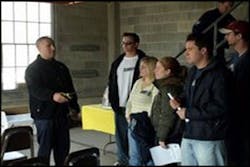Study Tests Drinking, Fires and College Students
COLLEGE PARK, MD. -- As part of a unique fire safety study, a group of young people at the University of Maryland spent part of last weekend drinking beer and then weaving around a dorm room.
Researchers hope their efforts last Sunday will help save the lives of college students in the future.
"The purpose is to gather data that illustrates the relationship between alcohol consumption and students' ability to get out of a simulated fire," explained Andrew K. Pantelis, Vice President of Prince George's County Professional Fire Fighters and Paramedics Association.
Study participants, aged 21 to 26, were asked to make their way through a darkened mock dorm room filled with a non-toxic fog to stimulate smoke. As the day progressed, students consumed controlled amounts of alcohol and were asked to go through the mock room over and over again.
Students performed each cycle with blood alcohol contents of .03, .06, .09 and .12. All participants were equip with safety equipment like helmets and knee pads, each participant had at least one safety officer assigned to them.
A member of the University of Maryland Police Department was on hand to measure blood alcohol content. Members of Prince George's County Fire/Emergency Medical Services Department evaluated the students after each cycle.
Pantelis said he hopes to take what he learns from the study, the first of its kind, and use it to teach incoming college kids about the dangers of drinking, specifically in the event of a fire.
"Our hope to develop a permanent simulator for the University of Maryland, and other college campuses nationwide."
Edward Comeau -- a frequent Firehouse.com contributor, as well as the man behind Campus Firewatch, an electronic newsletter -- was also there to watch the proceedings.
"I think it's a great study," he said. He said that it would provide a wealth of information for fire officials nationwide.
"This will quantify what we already know," he said.
Jamie Joroff, a firefighter/paramedic with Prince George's County, said she thought a program that actually shows college students the negative effect alcohol can have on them is a good thing.
"We see drunk college students all the time, and if they could go through something like this, it would be good," she said.
Indeed, according to Campus Firewatch, there were nine reported fatal fires involving college students during the 2007-2008 academic year, in which 18 students lost their lives. Although those fires all happened off-campus, the fact still remains that college students, relishing new freedom away from home, along with the newly acquired ability to drink legally, could sometimes be unaware of the danger they put themselves into.
A report put out by Campus Firewatch lists "impaired judgement from alcohol consumtion" among the top four causes of campus-related fire fatalities. The other three: lack of automatic fire sprinklers, missing or disabled smoke alarms, and careless disposal of smoking materials.
The young people who participated in the study seemed surprised by how the beer affected them, and how their assumptions about how drunk they were differed with their actual blood alcohol content readings.
They compared B.A.C. numbers and marveled over how differently each person reacted to the alcohol.
"I don't feel intoxicated," remarked Danielle Early , a former University of Maryland student who graduated in 2006. Early, who said she drinks several times a week, was much more steady than another participant, who said he only has a glass of wine a few times a month.
"I thought my B.A.C. was lower than it was, I thought I was going to blow below what was needed."
The study was held by the Prince George's County Fire/Emergency Medical Services Department in cooperation with the Maryland Fire and Rescue Institute, the Prince George's County Professional Fire Fighters and Paramedics Association (IAFF Local 1619) and the University of Maryland Police Department.
